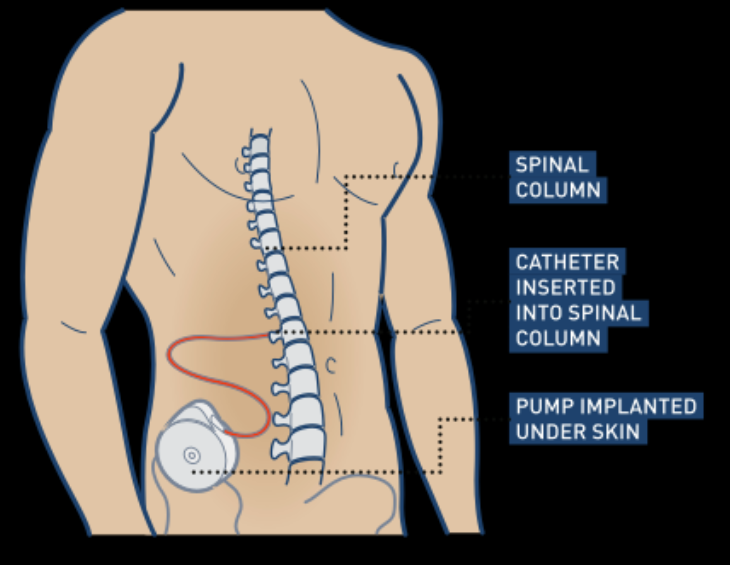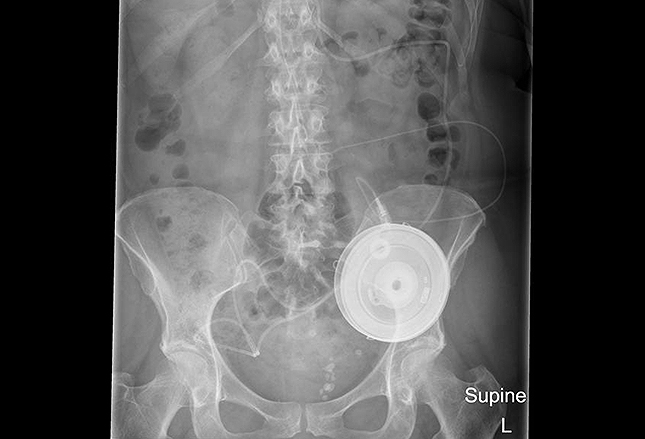This post is cross posted on REBEL EM
Definition: A dysfunctional condition in which removal of baclofen, an inhibitory neurotransmitter, from the central nervous system (CNS) causes CNS excitation. This post focuses on intrathecal baclofen administration and withdrawal. It should be noted that patients on chronic oral baclofen can also have withdrawal
 Pathophysiology of Baclofen (Goldfrank’s 2015)
Pathophysiology of Baclofen (Goldfrank’s 2015)
- Inhibitory neurotransmitter that acts as a GABAB receptor agonist
- Has both presynaptic and postsynaptic inhibitory properties
- Presynaptic: prevents Ca2+ influx
- Postsynaptic: increases K+ efflux
- Inhibition results in decreased muscle tone and muscle spasms
- Withdrawal likely results from loss of chronic inhibitory effect on postsynaptic receptors
- Withdrawal typically occurs 24-48 hours after discontinuation of the drug or a reduction in dose
Intrathecal Baclofen Pumps
- Catheter is placed into the cerebrospinal fluid (CSF) in the subarachnoid space
- Catheter is connected to a pump which is typically inserted into the lower abdominal wall. This pump has a reservoir that can be filled with baclofen
- Pump delivers baclofen in small amounts into the CSF causing inhibition at the spinal level
Causes of Baclofen Withdrawal (Stetkarova 2010)
- Baclofen dose reduction or cessation
- Intrathecal Pump Issues
- Catheter dislodgement, kinking or migration
- Reservoir underfilling: can occur if reservoir “missed” during medication refill leading to placement of medication in “pocket” around pump
- Pump device malfunction
Presentation
- Baclofen withdrawal mimics symptoms seen with other CNS depressant withdrawal syndromes
- History
- The patient may report a reduction in baclofen dose or cessation of the drug
- Increased spasticity
- Fever
- Myalgias
- Neuropsychiatric Symptoms: confusion, altered mental status, visual hallucinations
- Physical Examination
- Vital Sign Alterations
- Hypertension
- Tachycardia
- Hyperthermia
- Muscle rigidity
- Seizures
- Vital Sign Alterations
Note: Consider baclofen withdrawal in any patient who presents with vital sign abnormalities and has an intrathecal pump.
Differential Diagnosis
- Sepsis
- Alcohol withdrawal
- Benzodiazepine withdrawal
- GHB withdrawal
- Serotonin toxicity
 Diagnostics
Diagnostics
- The diagnosis of baclofen withdrawal should be made on clinical grounds as there is no specific diagnostic test.
- KUB X-ray
- Used to visualize mechanical dysfunction – catheter dislodgment, kinking or migration
- Will demonstrate spinal level of catheter
- Pump interrogation
- Typically performed by neurosurgery, interventional pain management or rehabilitation medicine
- Will reveal if pump is malfunctioning or if reservoir needs to be refilled
- Look for rhabdomyolysis
- Increasing spasticity in withdrawal can cause muscle breakdown which can lead to renal dysfunction
- Labs: Basic metabolic panel (for creatinine), urinalysis, creatinine kinase
Management
- Initial supportive measures
- Basics: IV, O2 (if hypoxic) and cardiac monitor
- Fluid resuscitation
- Patients have large insensible losses from fever, muscle spasm and increased respiratory rate
- Start with 20-30 cc/kg and repeat as needed
- Seizure management
- Similarly to alcohol withdrawal, seizures should be suppressed with CNS sedating agents and not typical antiepileptic drugs (i.e. phenytoin)
- Benzodiazepines are the 1st line agents
- Hyperthermia
- Aggressive external cooling
- Reasonable to administer antibiotics, obtain blood cultures and treat presumptively for infection as it can be difficult to differentiate hyperthermia from fever secondary to infection.
- Rhabdomyolysis
- Stop ongoing muscle destruction – relieve spasticity (see below), treat hyperthermia
- Administer IV fluids to maintain kidney perfusion and urine output
- Monitor patients for electrolyte abnormalities, particularly hyperkalemia
- Call poison center for expert toxicology consulation
- Directed medical management
- In the setting of baclofen withdrawal as a result of an intrathecal pump malfunction, oral baclofen is unlikely to be helpful because even with large doses, it is difficult to achieve adequate CSF levels
- Intrathecal Baclofen
- Optimal agent and route for treatment of baclofen withdrawal
- Options for administration
- Refill empty reservoir in functional pump without catheter obstruction
- Administer via catheter side port if pump malfunctioning but catheter intact
- Deliver via lumbar puncture (Shirley 2006). Should be done in consultation with neurosurgery as may be extremely technically difficult
- Benzodiazepines
- Treat withdrawal symptoms in a symptom triggered manner similar to the management of alcohol withdrawal
- Expect that patient may require large doses to control symptoms
- Propofol infusion
- Consider starting infusion early in management prior to significant hemodynamic decompensation
- Patient may require airway management with adequate propofol dose to manage withdrawal
- Other
- Numerous medications have been used in case reports and case series
- Examples: Dantrolene, Tizanidine (Ross 2011)
Disposition
- Balcofen withdrawal is a life-threatening syndrome and patients should be admitted to the ICU while arranging for definitive management
- Oral baclofen replacement is unlikely to fully treat the symptoms as it does not achieve adequate CSF levels.
- Pump or catheter malfunction typically requires neurosurgical intervention in the operating room
- If an empty reservoir is identified and refilled, the patient may be able to be discharged if all signs and symptoms resolve
Take Home Points
- Baclofen withdrawal from an intrathecal pump presents with hemodynamic instability, increased spasticity, fever and altered mental status. Consider the diagnosis in any patient with an intrathecal pump and the above symptoms.
- Oral baclofen replacement is unlikely to treat the disorder as it does not achieve adequate CSF levels.
- The optimal treatment for intrathecal baclofen withdrawal is administration of baclofen into the CSF but this can be technically difficult.
- Treat baclofen withdrawal with escalating doses of benzodiazepines and consider propofol infusion for patients who continue to decline.
References:
Hamilton R.J. (2015). Withdrawal Principles. In Hoffman R.S., Howland M, Lewin N.A., Nelson L.S., Goldfrank L.R. (Eds), Goldfrank’s Toxicologic Emergencies, 10e. Link
Stetkarova I et al. Procedure- and device-related complications of intrathecal baclofen administration for management of adult muscle hypertonia: a review. Neurorehabil Neural Repair. 2010;24(7):609-619. PMID: 20233964
Shirley KW et al. Intrathecal baclofen overdose and withdrawal. Pediatr Emerg Care. 2006;22(4):258-261. PMID: 16651918
Ross J et al. Acute Intrathecal Baclofen Withdrawal: A Brief Review of Treatment Options. Neurocrit Care. 2011;14(1):103-108. PMID: 20717751

Baclofen, a popular and effective treatment which also have side-effects, and individuals must consider them and choose other options such as Stem cell treatments.